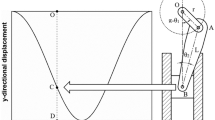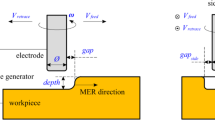Abstract
As servo presses were developed, forming modes became more diverse. However, limited by their own capabilities of motion mechanism, servo presses exhibited differences in the inputted and outputted motion curves, which caused result differences between forming analysis and actual forming. In order to change the servo motion curve to be similar to the actual motion curve, thus improving forming performance during finite element analysis. In this study, MATLAB software was used to construct a model of the motion behavior of a direct-drive servo press. The model was used to predict motion curves and compare metal forming times. However, the error between the motion curve of prediction model and the true motion curve is 13.84%. Therefore, the true motion curve was measured to construct a servo motion trend surface. Then, the servo motion trend surface was integrated with the prediction program to optimize the prediction model. Finally, the finite element analysis software DYNAFORM is used to explore the difference between the thinning ratio and forming force of cylindrical cups with the optimized servo motion curve such as the stepping curve, the coining curve, and the pulsating curve. The analysis result shows that between the optimized and actual servo motion curves, the thinning ratio and forming maximum force error are reduced by 4% and 4.11%, respectively.























Similar content being viewed by others
Data availability
The datasets generated during and/or analyzed during the current study are available from the corresponding author on reasonable request.
Code availability
Not applicable.
References
Osakada K, Mori K, Altan T, Groche P (2011) Mechanical servo press technology for metal forming. CIRP Ann Manuf Technol 60:651–672
Matsumoto R, Jeon JY, Utsunomiya H (2013) Shape accuracy in the forming of deep holes with retreat and advance pulse ram motion on a servo press. J Mater Process Technol 213:770–778
Ju L, Patil S, Dykeman J, Altan T (2015) Forming of Al 5182-O in a servo press at room and elevated temperatures. J Manuf Sci Eng 137:051009
Groche P, Hoppe F, Sinz J (2017) Stiffness of multipoint servo presses: mechanics vs. control. CIRP Ann Manuf Technol 66:373–376
Song Y, Dai D, Geng P, Hua L (2017) Formability of aluminum alloy thin-walled cylinder parts by servo hot stamping. Procedia Eng 207:741–746
Olaizola J, Bouganis CS, de Argandona ES, Iturrospe A, Abete JM (2020) Real-time servo press force estimation based on dual particle filter. IEEE Trans Ind Electron 67:4088–4097
Hu G, Pan C (2020) Investigation of the plastic hardening of metal thin-walled tube under pulsating hydraulic loading condition. J Mech Sci Technol 34:4743–4751
Singh SK, Mahesh K, Kumar A, Swathi M (2020) Understanding formability of extra-deep drawing steel at elevated temperature using finite element simulation. Mater Des 31:4478–4484
Tommerup S, Endelt B (2012) Experimental verification of a deep drawing tool system for adaptive blank holder pressure distribution. J Mater Process Technol 212:2529–2540
Abe Y, Ohmi T, Mori K, Masuda T (2014) Improvement of formability in deep drawing of ultra-high strength steel sheets by coating of die. J Mater Process Technol 214:1838–1843
Cui X, Li J, Mo J, Fang J, Zhou B, Xiao X (2016) Incremental electromagnetic-assisted stamping (IEMAS) with radial magnetic pressure: a novel deep drawing method for forming aluminum alloy sheets. J Mater Process Technol 233:79–88
Zheng K, Lee J, Lin J, Dean TA (2017) A buckling model for flange wrinkling in hot deep drawing aluminium alloys with macro-textured tool surfaces. Int J Mach Tools Manuf 114:21–34
Cao Q, Du L, Li Z, Lai Z, Li Z, Chen M, Li X, Xu S, Chen Q, Han X, Li L (2019) Investigation of the Lorentz-force-driven sheet metal stamping process for cylindrical cup forming. J Mater Process Technol 271:532–541
Ha J, Breunig A, Fones J, Hoppe F, Korkolis YP, Groche P, Kinsey BL (2019) AA1100-O cylindrical cup-drawing using 3D servo-press. IOP Conf Ser Mater Sci Eng 651:012094
Chen K, Korkolis YP (2020) Industry 4.0 in stamping: a wrinkling indicator for reduced-order modeling of deep-drawing processes. Procedia Manuf 51:864–869
Manoochehri M, Kolahan F (2014) Integration of artificial neural network and simulated annealing algorithm to optimize deep drawing process. Int J Adv Manuf Technol 73:241–249
Abe Y, Mori K, Maeno T, Ishihara S, Kato Y (2019) Improvement of sheet metal formability by local work-hardening with punch indentation. Prod Eng Res Devel 13:589–597
Si S, Wu Q, Mei D, Mao W, Song S, Xu L, Zuo T, Wang Y (2022) Numerical simulation and experiment of microstamping process to fabricate multi-channel of SUS304 thin sheets with different grain size. Int J Adv Manuf Technol 121:6739–6750
Cios G, Tokarski T, Żywczak A, Dziurka R, Stępień M, Gondek Ł, Marciszko M, Pawłowski B, Wieczerzak K, Bała P (2017) The investigation of strain-induced martensite reverse transformation in AISI 304 austenitic stainless steel. Metall Mater Trans A 48:4999–5008
Acharya S, Moitra A, Bysakh S, Nanibabu M, Krishanan SA, Mukhopadhyay CK, Rajkumar KV, Sasikala G, Mukhopadhyay A, Mondal DK, Ghosh KS, Jha BB, Muraleedharana K (2019) Effect of high strain rate deformation on the properties of SS304L and SS316LN alloys. Mech Mater 136:103073
Sunil S, Kapoor R (2020) Effect of strain rate on the formation of strain-induced martensite in AISI 304L stainless steel. Metall Mater Trans A 51:5667–5676
Li T, Kuo C, Yang C, Liu K, Li P, Lin B (2022) Influence of motion curve errors of direct-drive servo press on stamping properties. Int J Adv Manuf Technol 120:4461–4476
Tso PL (2010) Optimal design of a hybrid-driven servo press and experimental verification. J Mech Design 132:034503
He J, Gao F, Bai Y (2013) A two-step calibration methodology of multi-actuated mechanical servo press with parallel topology. Meas 46:2269–2277
Song Q, Guo B, Li J (2013) Drawing motion profile planning and optimizing for heavy servo press. Int J Adv Manuf Technol 69:2819–2831
Kim SY, Tsuruoka K, Yamamoto T (2014) Effect of forming speed in precision forging process evaluated using CAE technology and high performance servo-press machine. Procedia Eng 81:2415–2420
Kütük ME, Dülger LC (2016) A hybrid press system: Motion design and inverse kinematics issues. Eng Sci Technol an Int J 19:846–856
Sencer B, Tajima S (2017) Frequency optimal feed motion planning in computer numerical controlled machine tools for vibration avoidance. J Manuf Sci Eng 139:011006
Halicioglu R, Dulger LC, Bozdana AT (2018) Improvement of metal forming quality by motion design. Robot Comput Integr Manuf 51:112–120
Li C, Tso P (2008) Experimental study on a hybrid-driven servo press using iterative learning control. Int J Mach Tools Manuf 48:209–219
Halicioglu R, Dulger LC, Bozdana AT (2017) Modeling, design, and implementation of a servo press for metal-forming application. Int J Adv Manuf Technol 91:2689–2700
Chen T, Chen S, Wang C (2022) Punch motion curve in the extrusion–drawing process to obtain circular cups. Machines 10:638
Funding
This study was financially supported by Taiwan’s National Science and Technology Council (108–2221-E-992–064-MY3 and 111–2218-E-992–002) and the Frontier Metal Forming Research and Development Center from The Featured Areas Research Center Program within the framework of the Higher Education Sprout Project of Taiwan’s Ministry of Education.
Author information
Authors and Affiliations
Contributions
The authors’ contributions are as follows: all authors conceived and designed the study; Bor-Tsuen Lin, Chun-Chih Kuo, Kuo-Wang Liu, and Po-Hsien Li performed the theoretical deduction, performed the experiments and the finite element simulations, and performed the process optimization and analysis; Kuo-Wang Liu and Tse-Chang Li contributed to the interpretation of the results; Kuo-Wang Liu and Po-Hsien Li took the lead in writing the manuscript; Bor-Tsuen Lin, Tse-Chang Li and Chun-Chih Kuo contributed actively in writing the manuscript; all authors provided critical feedback and helped shape the research, analysis and manuscript.
Corresponding author
Ethics declarations
Ethical approval
The authors claim that none of the contents in this manuscript has been published or considered for publication elsewhere. Besides, the research contents of the article do not violate ethics.
Consent to participate
This manuscript does not involve human or animal participation or data, therefore consent to participate is not applicable.
Consent to publish
This manuscript does not contain data from any individual person; therefore, consent to publish is not applicable.
Competing interests
The authors declare no competing interests.
Additional information
Publisher's note
Springer Nature remains neutral with regard to jurisdictional claims in published maps and institutional affiliations.
Rights and permissions
Springer Nature or its licensor (e.g. a society or other partner) holds exclusive rights to this article under a publishing agreement with the author(s) or other rightsholder(s); author self-archiving of the accepted manuscript version of this article is solely governed by the terms of such publishing agreement and applicable law.
About this article
Cite this article
Lin, BT., Liu, KW., Li, TC. et al. Motion profile optimization of servo press in deep drawing process of SUS 304 stainless steel sheets. Int J Adv Manuf Technol 127, 4181–4198 (2023). https://doi.org/10.1007/s00170-023-11699-1
Received:
Accepted:
Published:
Issue Date:
DOI: https://doi.org/10.1007/s00170-023-11699-1




